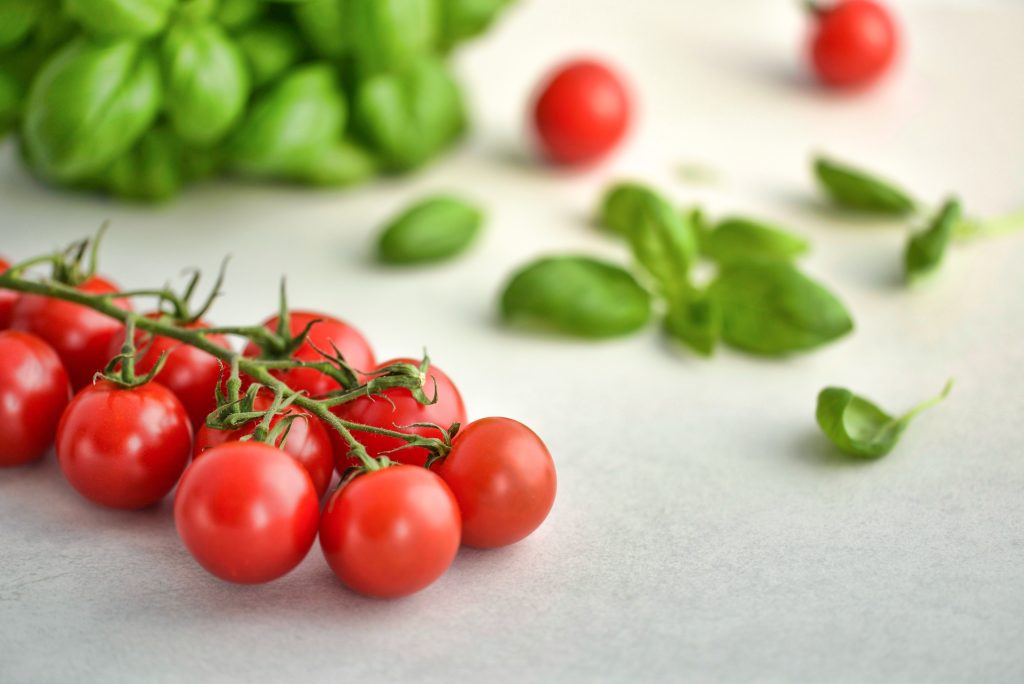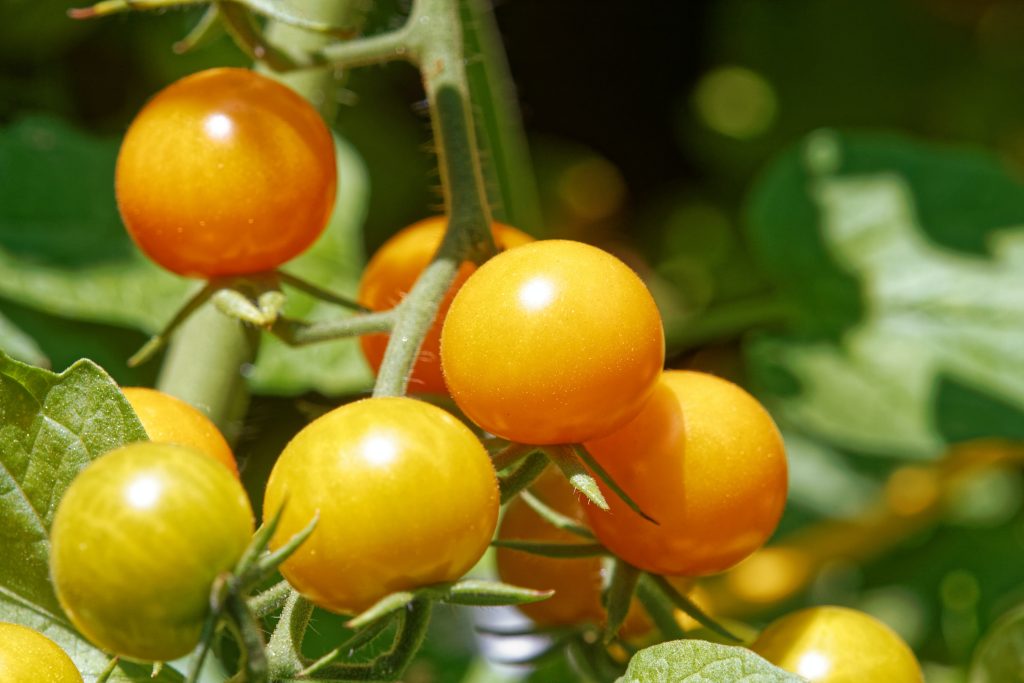
Cherry Tomato, there are many varieties I am growing. The above one is round in shape which is very sweet. They grow very tall like creepers. You will need to provide good support otherwise high chances of breaking the branches. Add egg shells for good supply of calcium. Once the plant grow about one feet it will start flowering. You can spray Epsom salt one tsp in one litter water every alternate week for better flowering. Cherry tomato, also known as a grape tomato, is a small-sized tomato with a round or oval shape, and it is a member of the Solanaceae family, which also includes potatoes, peppers, and eggplants. The fruit is usually less than an inch in diameter and is red, yellow, or green in color. Cherry tomatoes are popular in salads, as a snack, or used as a garnish. They have a sweet, juicy flavor and a thin, delicate skin, which makes them easy to eat raw. They are also used in cooking, especially in Mediterranean cuisine, and can be roasted, grilled, or used in sauces. Cherry tomatoes are rich in vitamins A and C, potassium, and dietary fiber. They also contain antioxidants such as lycopene and beta-carotene, which can help protect the body from various diseases. Due to their nutritional value and low calorie count, they are often recommended as part of a healthy diet. Cherry tomatoes are easy to grow and are commonly found in home gardens, as well as in commercial greenhouses. They require a warm and sunny climate and can be grown in containers or directly in the ground. Cherry tomatoes are considered to be one of the most prolific tomato plants, with each plant producing a large number of fruits throughout the growing season.
How to Grow Cherry Tomatoes?

Cherry tomatoes are small, sweet tomatoes that are easy to grow and perfect for snacking, salads, and cooking. Here are the steps to grow cherry tomatoes:
- Choose a location with plenty of sunlight. Cherry tomatoes need at least 6-8 hours of direct sunlight daily.
- Prepare the soil by adding compost and organic matter to improve soil fertility and drainage. Cherry tomatoes prefer well-draining soil that is slightly acidic (pH 6.0-6.8).
- Plant the cherry tomato seeds or seedlings in the prepared soil. If you are planting seeds, plant them 1/4 inch deep and 1 inch apart. If you are planting seedlings, space them 2-3 feet apart.
- Water the soil thoroughly after planting to settle the roots in the soil. Water regularly to keep the soil moist but not waterlogged.
- Fertilize the cherry tomato plants with a balanced fertilizer every 2-3 weeks during the growing season.
- Support the cherry tomato plants with a trellis, stake, or cage to keep the plant upright and prevent the fruit from touching the ground.
- Prune the cherry tomato plants by removing the suckers that grow between the stem and the branches. This will encourage the plant to focus its energy on producing fruit.
- Harvest the cherry tomatoes when they are fully ripe. The fruit should be firm, plump, and brightly colored.
With these steps, you can grow your own cherry tomatoes and enjoy a bountiful harvest throughout the growing season.
What are the benefits of cherry tomatoes?

Cherry tomatoes are a great source of vitamins, minerals, and antioxidants. Here are some of the benefits of cherry tomatoes:
- Nutrient-dense: Cherry tomatoes are low in calories and high in nutrients, including vitamin C, vitamin A, potassium, and fiber.
- Antioxidant-rich: Cherry tomatoes are a rich source of antioxidants like lycopene, which can help protect your cells from damage caused by free radicals.
- Heart-healthy: The potassium and fiber in cherry tomatoes can help lower blood pressure and reduce the risk of heart disease.
- Cancer-fighting: Lycopene, the antioxidant found in cherry tomatoes, has been linked to a lower risk of certain types of cancer, including prostate cancer.
- Immune-boosting: Vitamin C, which is abundant in cherry tomatoes, is essential for a healthy immune system.
- Eye health: The vitamin A in cherry tomatoes is important for maintaining healthy eyesight.
Overall, incorporating cherry tomatoes into your diet can provide a range of health benefits and contribute to a balanced and nutritious diet.
How To Eat Cherry Tomatoes?
Cherry tomatoes are a versatile ingredient and can be enjoyed in a variety of ways. Here are some ideas on how to eat cherry tomatoes:
- As a snack: Cherry tomatoes make a delicious and healthy snack on their own. Simply wash them and enjoy them as is.
- In salads: Cherry tomatoes add color, flavor, and texture to any salad. Add them to green salads, pasta salads, or grain salads.
- Roasted: Roasting cherry tomatoes brings out their natural sweetness and intensifies their flavor. Toss them with some olive oil, salt, and pepper, and roast them in the oven for a few minutes.
- Grilled: Grilled cherry tomatoes make a great side dish or topping for burgers or sandwiches. Simply skewer them and grill them over medium-high heat for a few minutes.
- In sauces: Cherry tomatoes can be used to make a simple and delicious tomato sauce. Simply sauté them with some garlic and olive oil, and puree them in a blender or food processor.
- As a garnish: Cherry tomatoes can be used as a colorful and flavorful garnish for a variety of dishes, including soups, stews, and casseroles.
Overall, cherry tomatoes are a versatile ingredient that can be enjoyed in many different ways. Be creative and experiment with different recipes to find your favorite way to eat them.
How To Store Cherry Tomatoes For a Long Time?



Cherry tomatoes can be stored for a long time if they are stored properly. Here are some tips on how to store cherry tomatoes for a long time:
- Don’t wash the tomatoes: If the cherry tomatoes are not yet ripe, it is best to leave them unwashed as the moisture from the washing can cause them to spoil faster. You can wash them just before using them.
- Store at room temperature: If the cherry tomatoes are fully ripe, store them at room temperature, away from direct sunlight. This will help them to ripen fully and develop their flavor.
- Store in the refrigerator: If you have ripe cherry tomatoes that you want to store for a longer time, place them in a plastic bag and store them in the refrigerator. Make sure that the bag has some holes to allow for air circulation. This will help to slow down the ripening process and keep the tomatoes fresh for longer.
- Freeze the tomatoes: Cherry tomatoes can also be frozen for later use. Simply wash and dry the tomatoes, then place them in a single layer on a baking sheet and freeze them until they are firm. Then transfer them to a freezer-safe container or bag and store them in the freezer. These frozen cherry tomatoes can be used in soups, stews, or sauces.
By following these tips, you can store cherry tomatoes for a long time and enjoy them even when they are out of season.
What are the nutrients in cherry tomatoes?



Cherry tomatoes are a small but nutritious fruit. Cherry tomatoes are a great source of vitamins, minerals, and other nutrients. Here is a list of some of the key nutrients found in cherry tomatoes:
- Vitamin C: Cherry tomatoes are an excellent source of vitamin C, which helps support a healthy immune system, skin health, and wound healing.
- Vitamin A: Cherry tomatoes are also rich in vitamin A, which is important for maintaining healthy eyesight, skin, and immune function.
- Potassium: Cherry tomatoes are a good source of potassium, which helps regulate blood pressure and supports healthy heart function.
- Fiber: Cherry tomatoes are a good source of fiber, which helps support healthy digestion and can help you feel full longer.
- Antioxidants: Cherry tomatoes are rich in antioxidants like lycopene and beta-carotene, which help protect cells from damage and may reduce the risk of chronic diseases like cancer and heart disease.
Overall, cherry tomatoes are a nutritious and delicious addition to a healthy diet.
